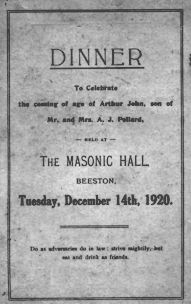 Arthur Pollard & John Pollard: 1918-52 -
After World War I the lace trade never returned to its former prosperity. The war was inevitably a bad time for the trade, but after the war there may
have been a brief period of optimism. The celebration of John Pollardís 21st birthday at the Masonic Hall, Beeston in 1920 (Click the image for the
full programme) provides us with a period piece - an entertainment, with songs and monologues by factory hands1 - and perhaps a feeling
that the future was secure. The celebrations continued on the way home and our father told us that happy workers climbed the statue of Hope in Beeston
Square2 and gave her a scarf to wear.
Arthur Pollard & John Pollard: 1918-52 -
After World War I the lace trade never returned to its former prosperity. The war was inevitably a bad time for the trade, but after the war there may
have been a brief period of optimism. The celebration of John Pollardís 21st birthday at the Masonic Hall, Beeston in 1920 (Click the image for the
full programme) provides us with a period piece - an entertainment, with songs and monologues by factory hands1 - and perhaps a feeling
that the future was secure. The celebrations continued on the way home and our father told us that happy workers climbed the statue of Hope in Beeston
Square2 and gave her a scarf to wear.
In another positive development, away from the factory, our parents married in 19223; a marriage that lasted 74 years.
The problems of the lace trade continued, as economic depression hit hard. The Pollards concentration on fine lace, for which there was a declining
demand, would not have helped.
A notebook, belonging to Albert Burnham the improver (see the Lace Machines page) shows weeks with and without work from the coal strike of October 1920 until
December 1924. There were some weeks on half time and many with no work at all. In 1923, the worst of these years, alternate weeks were worked much the year, so
providing a regular small income.
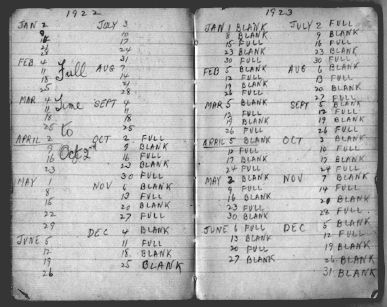
Arthur Pollard, concerned for his hands, put a notice on the factory wall - married men to be paid 30/- a week, single men 17/6d, when not working.
The Lace Manufacturersí Federation made him to withdraw the offer. Johnís brother Walter left England for a new life in Southern Rhodesia (Zimbabwe) during
the general strike of 1926, travelling to Southampton by taxi. He started a garage business and returned only once, in 19734>.
The problems for the lace industry were not just the depressions, but also fashions. The simple lines of the dresses of the twenties, the Charleston era,
had little need for lace. The depression of the 1930s was just as severe and fashions little kinder; the lace industry struggled on. A local measure of
decline is found in the Anglo Scotian books; the number of tenants fell from 15 in 1910 to four in 1935 as small lace firms went out of business5.
The second World War brought Leavers lace making to a stop, except for limited exports. At Pollards, as far as we know, only hairnets were made and Swiss Mills
was used to store army clothing, baled rubber and other military supplies. After the war, a newspaper reporter6 taken around the factory by Arthur Pollard,
found the machines idle, but in good condition - "they could be operated any day" - with only John Pollard working a machine, making hairnets. By
the time matters began to improve in the early 1950s it was too late for the Pollards. Their machinery was obsolete and the way forward, for the small number
of surviving firms, was with new technology7. In Beeston and Chilwell, where at least ten lace factories operated for some part of the period from
the 1850s to the 1950s8, the industry soon came to an end as a major employer.
Many old machines at the Pollardsí Beeston factories were scrapped between 1921 and 1950, but the earliest significant sales of working machines were in 1951,
when 14 were sold, presumably taking advantage of a short-lived period of optimism about the future of lace. After Arthur Pollardís death in 1952, there was a
valuation of the machines, by A.E. Spowage, of Spowage, Humphreys and Wyer, after which virtually all were sold or scrapped. Some went to America, others to
the machinery makers Hooton.
The final sale was in 1954, when two Cooper machines were sold to Masons of Ilkeston; one of these, illustrated on page 26 of Sheila Masonís book, is now on
loan to the Industrial Museum at Wollaton Park. By 1956 all the machines had gone.
The Anglo Scotian was sold in the 1960s to two of the (non lace) tenants and now the buildings have been converted into apartments. Our childhood view of the
ornate Villa Street entrance (shown on a previous page) is a rare survival in what is otherwise to us a vanished landscape. Much of the Swiss Mills complex
was, like the Anglo, sold in the 1960s9; However, John Pollard retained some buildings, including his office in the earliest four-story building, for
several more years.
In 1984, the Wollaton Road end of the site, including the Swiss Mills building was destroyed in a spectacular fire.
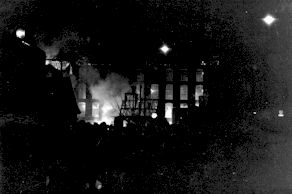 
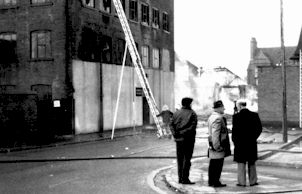
John Pollard was then 84 (shown on the day after the fire, in the centre of the group10), but even after the fire he walked down to his factory
office from his house in Park Street every working day. Into his late 80s, he looked after his one or two remaining (non-lace) tenants, talked with old
Beestonians about times past and wrote notes about the history of the factory for his children. At home in the afternoon
he was busy in his garden and may well have wryly described his occupation as "gardener", as did his great grandfather Thomas in the 1870s. He sold
the last remnants of Swiss Mills in 1988 and died in 1997 at the age of 97. Now shops and offices occupy the site, clean, bright and characterless. Cromwell House,
built by John Pollard senior was demolished in the 1950s and the site of the Pollardsí Villa Street home, Chestnut Villa, is now part of Sainsburyís car park.
Our father was unlucky in that his working life coincided with inevitable decline in the lace trade; his last duty was to oversee the end of lace making by the
family. He did it with dignity and good humour. His long life and intimate knowledge of the lace trade made him one of the most valuable sources of information
for Sheila Masonís history of Nottingham Lace. Like the other Pollard factory owners, John was a hands-on lace maker, and we finish our history with a photograph of
him in the early 1950s at a machine making lace, where he was happiest and where he had spent so much of his working life.
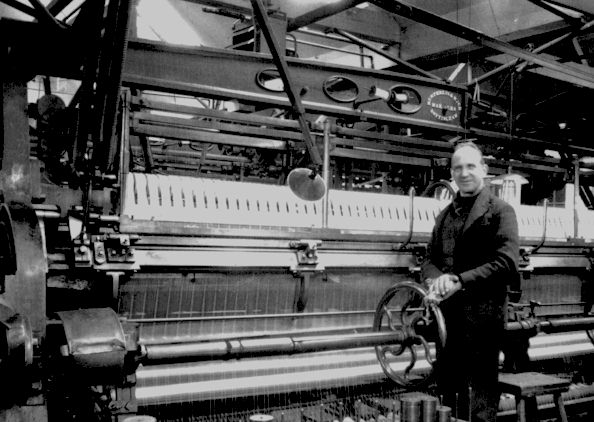
1 We are unsure whether all the entertainers were from the factory. There was a separate party for the women.
2 The Boer War memorial, now at Broadgate.
3 John Pollard married Hilda Doar, daughter of a grocer and wine merchant in Beeston Square.
4 We remember him telling us that, as a boy, he climbed to the top of the Anglo chimney.
5 An Anglo Scotian tenant, A. Parkes, bought the front of the factory (with its Gothic facade) in c1923, giving it the local name Parkesí
Factory. Thus 1910 and 1935 are not fully comparable years.
6 Beeston Gazette and Echo, 20 September 1947. One of a series, based on interviews, of open letters to men who had played a notable part
in the industrial life of Beeston.
7 At the end of the war, at the first textile trade exhibition in Leicester, Arthur and John Pollard decided to import a Raschel warp lace
machine, but were prevented by the Government: recounted by John Pollard in conversation with Sheila Mason. It would have been the first such machine used in this country.
8 S.M. pp 256-262.
9 Note by John Pollard; 10,13,14 on plan (Appendix 1) sold to Keeble 1961; 16,17,18 sold to Boot 1966.
10 The damaged buildings, including Dobson's Mill shown in this picture, were demolished.
Click to read the next chapter
or -
Click here to go back to the top
|
 |